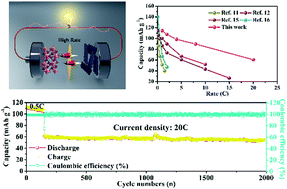High-rate and non-toxic Na7Fe4.5(P2O7)4@C for quasi-solid-state sodium-ion batteries†
Abstract
A sustainable and non-toxic polyanionic cathode material is an ideal choice for high-performance eco-friendly sodium-ion batteries (SIBs), but most of the polyanionic cathode materials contain vanadium/chromium or other toxic atoms. Based on Fe atoms, pyrophosphate polyanionic Na7Fe4.5(P2O7)4 is a promising candidate to meet the sustainable, non-toxic and cost-effective requirements. However, its inferior rate capability hinders its further application. Besides, employing quasi-solid-state polymer electrolytes (QSPEs) is an advisable strategy to mitigate the shortcomings of traditional SIBs caused by liquid electrolytes. In light of this, a high-rate carbon-coated Na7Fe4.5(P2O7)4@C (NFPO@C) cathode and a quasi-solid-state polymer electrolyte membrane (PFSA-Na) with high ionic conductivity are provided in this work. Quasi-solid-state full cells based on the NFPO@C cathode, the PFSA-Na membrane and the hard carbon anode can enable high-rate performances and extremely stable cycle life at 20C with a capacity decay of 0.0057% per cycle for 2000 cycles. The NFPO@C cathode material, PFSA-Na membrane and full cells demonstrated here could pave the way for high-rate quasi-solid-state sodium-ion batteries for practical application.

- This article is part of the themed collection: Energy storage with rechargeable Li batteries and beyond


 Please wait while we load your content...
Please wait while we load your content...